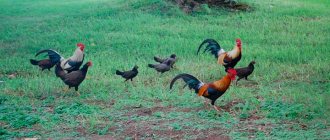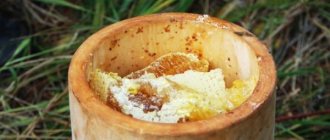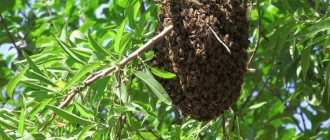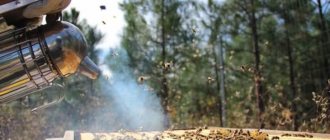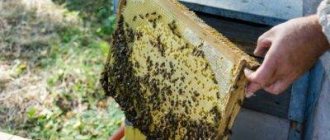The oldest insects on the planet are wild bees. Being excellent pollinators, they rightfully occupy a special place in the ecosystem. The number of insects is inevitably declining as humanity, spreading across the earth, leaves fewer and fewer suitable areas for survival.
If the death of these amazing creatures is not stopped, then, according to scientists, they will disappear from the face of the planet by 2035. Only one active reserve currently supports the species' population. These are the unique forests of Bashkiria, where “free” honey plants are still protected and the healing product of their vital activity – wild honey – is collected.
Origin
This is what a swarm of wild bees looks like, photo:
Wild bees are a group of flying insects. It belongs to the order Hymenoptera. Appearance, behavioral characteristics, and vital functions are studied by the science of “Apiology.” The ancestor of honey plants is the predatory wasp.
The transition from insectivorous feeding to pollen eating presumably occurred gradually through the consumption of insects that pollinated plants and were covered in pollen.
The oldest fossilized bee was found in amber in 2006. The age of the find dates back to the Cretaceous period (100 million years).
The word “bee” itself has ancient Slavic origins. This form of designation is onomatopoeic “bučati” - “to buzz”. Any insect of this group has two pairs of wings, a proboscis, a sting, and glands with poison.
Where do wild bees live?
The favorite natural habitat of bees is forest plantations and forests. The main condition is distance from roads, industrial centers, and human settlements.
The ideal place for a family is a hollow. The nest can also be built between tree branches in a dense crown, in crevices of walls or mountains. Burrows dug in the soil are also suitable for settlement.
Sometimes a convenient place to live is close to a person. A gap under the roof of a barn or house, the space between frames, etc. is suitable.
A place for a family home should be suitable in many ways. The most important of them is the presence of a constant source of water nearby.
Kinds
Modern scientists have described more than 20 thousand varieties of winged insects. Their main benefits are plant pollination, production of honey, propolis, wax, and bee bread.
Most births are considered "public". Each member of the community has his own “place” and specific responsibilities:
- young insects feed the queen and raise brood;
- individuals at the age of 10 days produce wax and are engaged in the construction of honeycombs;
- Bees become scavengers and cleaners by the 15th day of life;
- adult “workers” collect honey.
Semi-social species live in small colonies. The family size reaches up to 12. They are distinguished by a one-year development cycle and a common goal - to survive the winter.
Solitary species do not collect honey, but are good pollinators. The Osmia bee is a subspecies of solitary insects. This is one of the most active pollinators. In some regions of the USA and Canada they even began to cultivate it. A distinctive feature of the species is its simplicity of maintenance.
Osmia uses natural shelters to lay eggs:
- reed cavities;
- holes in wood;
- cracks in the bark, etc.
At the bottom of the “house” the queen lays first the eggs of the female, then the male. They develop faster. The female places a supply of food in each cell and seals it with a cork.
Wild bee eggs
The larvae remain closed until spring. The queen, having filled several nests, dies. As the weather warms up, the young generation comes out and the cycle begins anew.
This type of bee is very peaceful, which allows them to be used in greenhouses.
Among them there are also parasites. They got their name for their similar behavior to the Cuckoo bird. Trying to provide better conditions for their offspring, they penetrate someone else's nest and lay their eggs there. The larvae grow and develop on the family's food supplies. They do not build their own nests.
A distinctive feature of the species is the absence of an apparatus for collecting pollen. Most individuals have virtually no hair. Outwardly they look more like wasps. There are several thousand species of such parasitic bees.
Hives
There are various types of hives found in the natural environment, including those located in trees. They are small bags made from dried leaves, grass and natural adhesives. Before the onset of cold weather, bees actively work: they cover cracks with propolis, raise young brood, and drive out lazy drones.
After the work is completed, the bees gather at the bottom of the hive; this place is considered the warmest; there are no honeycombs in it.
Earth bees, like ants, live in groups and dig through a lot of tunnels underground. At the end of the move, they locate a hole, compacting it with their paws and wetting it with their saliva.
This is how bees create compact and safe homes for themselves, each of which contains an egg on a cushion of flower nectar. The saliva hardens and becomes a hard film, due to which neither water nor cold penetrates into the houses.
Appearance
Wild honey plants and domestic workers have a lot in common. But species bred by nature differ from those selected even externally:
- The first difference is color. Wild individuals are distinguished by monochromatic, discreet colors. Muted tones. Household “workers” are very smart and bright.
- Size. Selected breeds are much larger than their forest relatives.
- Wild individuals have a protective shell on their chest.
- The front pair of wings is longer than the back. Thick hair coat protects from cold.
Wild individuals have the same body structure as domestic ones:
- two pairs of wings;
- head;
- breast;
- belly;
- paws;
- proboscis;
- sting.
They are also characterized by a hairy covering and a chitinous skeleton. Excellent vision is evidenced by the presence of two compound and three simple eyes.
Both females and males have antennae in varying numbers. This organ of smell is endowed with increased sensitivity. Serves to determine the level of heat, humidity, and the presence of carbon dioxide in the nest.
Taste buds are located on the proboscis and paws. The lower lip transformed into a proboscis. The top one looks like a chitinous plate. The sting is located at the end of the abdomen.
There are a few nicks on the surface. Therefore, after a bee stings an enemy, it lingers in the body. The bee itself always dies.
Where do they winter?
Bee hollow in winter
“Free” honey plants spend the winter in their nest. With the onset of the cold season, the house is cleaned. Bees clean out debris, expel drones, and seal honeycombs with wax plugs. Protecting their home from drafts and excessive humidity, insects seal the cracks with propolis.
By the end of autumn, honey plants gather in a large lump. Its density depends on the ambient temperature. The colder it is outside, the denser they cluster. Insects of the upper tier are inactive. Inside, individuals actively move, generating heat. The “core” temperature reaches 350.
Gradually the bees change places. Individuals, moving inside, warm up and begin to generate heat themselves. The family, using food supplies, slowly moves up.
For successful wintering the main conditions must be met:
- strong numerous swarm;
- honey supply;
- preparing the house (absence of draft and dampness);
- peace and quiet around the winter hut.
When metabolism slows down in cold weather, one bee needs up to 7 mg of food per day.
Nutrition
It is already clear that the most important product that these insects eat is honey. But the quality of this substance depends on many factors. For example, from how these little creatures survived the hardships of winter. In addition, the taste of honey is greatly influenced by the type of plant from which the nectar is extracted.
It is best that these representatives of the flora do not contain excess glucose, sucrose and carbohydrates, because such elements contribute to the accelerated crystallization of this product. And in this form, honey cannot be fully consumed by bees.
And even after collecting a significant amount of this substance, they are quite capable of dying of hunger. Undesirable plants, for example, include mustard, heather, cotton and some others.
In cases where its nutrition is not of sufficient quality, the bee suffers greatly. And all members of the nest become susceptible to disease and feel unwell. Good honey plants include: apple, cherry, pear, willow, linden and many others.
Reproduction process
Mating Process
After the queen bee flies out of the nest, she is accompanied by drones. During the mating flight, the male and female mate. The queen returns to the nest, where she lays up to 2 thousand eggs daily, while drones that are no longer needed are expelled.
The lifespan of the uterus is about 5 years. During this period of time, she manages to lay more than 2 million eggs.
What does a wild bee's nest look like?
The houses of wild families are located in tree hollows. The internal structure always exactly matches the size, shape of the “room” and the location of the taphole.
Construction always starts from the bottom tier. The honeycombs are tightly attached from the sides and top. The bottom is made rounded. A new family rebuilds 5-7 plates. Their size depends on the size of the swarm, location, and time of “building.” However, the distance between the honeycombs is always maintained the same - 12.5 cm.
As the number of individuals increases, the house expands and can grow up to two meters in diameter. The insects will definitely “close” the large hole at the entrance, while the small one will gouge it out.
The lower entrance is located at a height of up to 7 meters. The nest is built on the south side of the trees. There should be a water source nearby. Usually bees choose an old linden tree or aspen tree with a hollow. If the trunk begins to hum when tapped, then the nest is nearby.
Wintering
Strong insects raised in the wild survive wintering well in a hollow. A nest box is an empty cylinder that is located in tree trunks. The bees will carefully polise the top and walls of the tree. This allows you to keep moisture, cold and cold air out of your home. Ventilation occurs through the lower entrance, thoughtfully made by the bees. The club is located at the bottom, and the honeycomb is at the top. There is an air cushion between the honeycomb and the entrance. During wintering in a nest, the residents' metabolism slows down, which allows them to save energy for the spring.
How are wild bees different from domestic bees?
Domestic bees
Signs of an ordinary bee colony can also be observed in wild nests. The queen dominates the entire community. She lays eggs. The main composition is working individuals.
At different stages of life they are responsible for certain areas of activity:
- uterine care;
- brood nursing;
- hive cleaning;
- honeycomb construction;
- honey collection.
Wild Bee
Differences:
- invisible color;
- small size;
- high level of vital activity;
- great hard work and high activity;
- strong immune system;
- external protection in the form of thick hairs allows you to survive in severe frosts down to – 500;
- aggression, attacking an enemy without warning.
Appearance and behavior should protect against external enemies and promote survival.
Division of a bee colony
After moving the apiary to a forest clearing, the time comes to think about dividing the bee colonies, so as not to miss the honey collection during the swarming. It is best to start the planned task in the spring, before the start of the main honey collection, during the flight of bees, and before that, prepare an empty hive. Division into the floor of the nest is done by laying out the bee property in half. Having distributed the frames with bees, beebread, honey and future offspring, the hive must be tightly closed and placed not far from the family’s former place of residence. It is not difficult to determine which of the new dwellings the queen is in and which is not. Where the “mistress of the hive” is present, hymenoptera insects behave quietly and calmly. If the bees are noticeably fussing around the entrance area, then there, to the other half of the bee family, you also need to replant the previously acquired queen. After which, the hive entrances are gradually turned in different directions so that the bees get used to the new home and become attached to it. With these simple steps you can prevent swarming and get a new strong swarm.
Benefits of wild honey
The collection of “wild” honey occurs in the autumn, it has time to fully ripen, gain useful substances, and become saturated with its delicate, natural aroma and taste.
Honey is popularly used in cosmetology, folk and traditional medicine. It is generally accepted that it allows one to cope with various diseases, including diseases of the gastrointestinal tract, bronchi, heart, lungs, etc.
It also helps reduce inflammation and pain.
“Wild” honey is a special product that has unique healing properties due to its rich composition:
- many vitamins;
- bee bread, wax and propolis;
- macro- and microelements;
- minerals.
Harvesting wild honey
This is a rich and fully ripened product. The maximum value is obtained through manual collection, which allows not to disrupt the activity of insects. When processing raw materials, no mechanical interventions are used.
Traditional medicine often refers to the medicinal properties of wild honey. It has been observed that honey increases appetite and improves metabolism.
With its help, it is possible to normalize cardiac activity and capillary patency, and cure diseases associated with the gastrointestinal tract.
What other problems does honey help fight:
- helps treat kidney disease;
- improves the treatment of respiratory diseases;
- allows you to improve your condition with elevated body temperature, inflammation, and sore throat;
- improves blood circulation of internal organs;
- effectively relieves muscle pain and joint spasms.
The distinctive features of the product are its dark and rich shade, similar to buckwheat. Honey predominates with a heady aroma with a slight admixture of smoke, a viscous, very thick composition of the mass, and astringency.
How to catch?
Trap for bees
To breed honey plants, the most important thing is to provide them with their usual “housing”. They choose trees and build hollows. You can prepare decks.
You can catch a family in different ways:
- During swarming, specially prepared traps are installed. Place them in a quiet, secluded place on a tree.
- After smoking out the inhabitants of the nest, the honeycombs with brood are collected and placed in a new nest.
- A labor-intensive method is cutting out a hollow tree.
Fishing technique
Another trap
Traps for catching swarms are made of simple plywood. Frames are placed inside. No more than 8 pieces. For bait they put one or two old ones, the rest can be simply tied with wire. A free space of 2 cm is left between the bottom of the box and the honeycombs.
The trap is fixed with ropes and slings closer to the crown at a height of 5 meters. It is better to choose trees near a clearing or clearing. The box is checked every 7 days. The swarming period lasts from late May to July. If a swarm has settled in a trap, it is lowered from the tree and transported.
The trap is removed after sunset when the bees return. Carefully, without making too much noise, the beekeeper climbs the tree and closes the valve.
It must be secured to prevent accidental opening during transport. When organizing the descent, you need to take into account that the weight of the temporary hive will be more than five kilograms.
Taming
Forest beekeeping is the breeding of insects in natural conditions. This work requires experience and knowledge. Families are fed regularly. Provide fresh water. If they are left to live in the hives, then insulation for winter is mandatory.
Taking honey from wild bees is dangerous! You cannot do this yourself without the help of an experienced beekeeper.
Scolia - the most beautiful large-sized wasp
The huge Scolia wasp is a striking specimen among giants, the titled giant of Europe. The extensive family includes hundreds of species, but the most interesting is the giant Scolia. The heat-loving insect lives in southern countries, southern Europe, the Caucasus and Crimea. As the climate warms, the distribution boundaries of the huge wasp are expanding. Scolia are not found in cold regions because the larvae have no chance of survival in cold soil. The insect is listed in the Red Book.
A very large wasp grows up to 5.5 cm. On average, the length of females ranges from 4-5 cm. Males are somewhat smaller and their sizes do not exceed 25-32 mm. Nature did not spare the colors when painting the scolia. The main background of the body is black. The yellow dorsal shield and spots on the abdomen of the same color stand out in contrast.
Adult wasps emerge at the end of May and their active years begin. Peak activity occurs during the daytime. They spend the evening and night hours buried in the upper layers of soil or under plant litter.
The short mouth proboscis forces huge wasps to be selective in their choice of food supply. They can extract nutrients only from Asteraceae, umbelliferous plants, which are characterized by a shallow corolla.
Refreshed females begin mating. The fertilized female individual goes into the soil, where it digs holes. It is no coincidence that the female leads an underground lifestyle. After all, only here can she find a suitable host for her parasitic larva.
The female, cramped in underground conditions, cannot attack her prey several times. And it faces two tasks: to paralyze the future host of the larva and preserve its viability. In addition, the victim must have sufficient mass to provide the Scolia offspring with all the necessary nutrients.
Since the necessary hosts mainly live in the soil layers, in a moist substrate, the wasp has to look for them in underground burrows. Having found a suitable object, the female accurately determines the location of the strike and inserts her sting. The poison paralyzes the victim, and Scolia lays a tiny 1 mm egg in the abdomen.
The larvae hatch after 7-14 days. A newborn individual barely reaches 2 mm. Looking at her, it is difficult to imagine that in the future she will become a large wasp. The body of the larva is equipped with sharp jaws in the form of hooks, and it immediately begins gnawing the integument of the host.
When the host is finished, the larva spins a web and fences itself off from its remains. Within a few days, she builds a cocoon and goes into a dormant state. Development resumes in the spring, the pupation stage lasts about a month and a young, mature Scolia flies out from under the soil.
Wild bee sting
Place of bite
The concentration of poison in a wild insect is much higher than in a domestic one, so the pain is much stronger. Swelling of the affected area and an increase in the victim's body temperature are possible.
First aid for bites:
- remove the sting;
- squeeze out the poison;
- treat the affected area with any available disinfectant;
- take an antihistamine (Fenkarol, Suprastin, etc.);
- apply a cold compress;
- Drinking plenty of fluids is recommended.
Numerous wild bee stings are dangerous to human life and health. A severe allergic reaction is possible. You should consult a doctor immediately.
Ground bees and humans: is peaceful coexistence possible?
Ground bees live underground, often choosing garden plots as a place to live, especially if honey plants grow on them in large quantities. Their priority is buckwheat, dill, parsley, celery and sunflower. If these plants grow on your site, then it is quite possible that earth bees will become your guests. However, there is nothing wrong with that.
Firstly, earth bees do not settle in very large colonies to cause significant discomfort to humans, and secondly, they are not aggressive if they are not touched. In addition, you can also benefit from such a neighborhood, because earth bees are excellent pollinators. Well, for extreme sports enthusiasts, there is an opportunity to enjoy the honey of wild bees, but you should take into account the high risk of being bitten; earth bees do not like uninvited guests. Suppose earth bees have settled on your site, how to get honey, you ask? To do this, it is worth understanding the lifestyle of this insect.
The home of earth bees is a whole system of underground passages and tunnels and dead ends; they often occupy underground storage facilities already prepared by other animals, and less often they create their own. In the process of extracting honey, the most important thing is to determine where the dead ends are located, which bees use to store honey, having previously prepared them. To do this, a cell is dug in the tunnel, the soil in the process is treated with the bee's saliva and strengthened with the secretion of the abdominal gland.
In fact, it is an analogue of the honeycomb of ordinary bees, where honey is collected. In addition, a place for hatching is prepared in the same way; an egg is placed in a similar “honeycomb” filled with nectar. This is worth considering when collecting honey, as approaching the offspring can make the bee family very angry.
To summarize, the main goal when collecting honey from wild bees is to find a place where it is stored underground, then, using a shovel and other available tools, find the “honeycombs” of wild bees and collect the honey.
In this case, it is worth taking special precautions, since, for example, it is unlikely that it will be possible to smoke underground bees out of their homes, as is the case with ordinary ones, due to the large branched underground system of their homes
Due to the difficulties and impracticality of collecting honey from wild bees, many summer residents prefer to destroy their colonies on their plots. search engines are often faced with the query: how to destroy earth bees? And several traditional methods are usually recommended:
- digging up a vegetable garden, a garden where bees have settled.
- flooding the discovered minks with water and special substances.
- plugging the entrances to the bees' home with rags soaked in dichlorvos, gasoline, etc.
- placement of poisoned baits on the site.
However, before using one of these methods, think about whether you need it. Ground bees are generally harmless and, as mentioned above, are excellent plant pollinators. In addition, some species are listed in the Red Book.
How to fight?
Wild bees settle in forest areas. Nests also appear near human habitation. Such a neighborhood frightens people because they are aggressive in nature.
You can get rid of “neighbors” in different ways:
- Protect the area from insects with a high fence. Flying over a large barrier is very tiring for wild honey plants; they will look for a more accessible place to “work.”
- Lavender bushes planted on the site will protect the area from uninvited guests.
- Fumigating indoors and outdoors with herbs with a strong aroma (mint, oregano, sage) will drive away unwanted neighbors.
- You can get rid of the swarm by handing it over to a beekeeper. The beekeeper will help catch the family and move it to a sufficiently distant distance from the old place.
- Earth species do not cause any harm. If the nest interferes with planting work, it is poured with boiling water or treated with pesticides.
Tired of the dangerous neighborhood
Since it so happens that unwanted neighbors have appeared, there is no need to rush. Take care of the environment, plants and insects themselves. They are very useful for plants and there are very few of them in nature.
Do not buy chemicals to destroy all living things. Look for specialists who can help cope with such a scourge. These could be local beekeepers or beekeepers. Ask them to take the swarm to another location. If you don’t know any beekeepers or neighbors, don’t be upset. The veterinary service deals with such issues; they certainly know how to get rid of wild bees. The worst case scenario is to do it carefully yourself. Necessary:
- Make a bait hive. This is a wooden box or cardboard box.
- Find a convenient place, close to the location of the wild swarm.
- Cover the trap with branches or bushes.
- Mark the inside of the box with queen pheromones. Lemongrass oil is also suitable. All this can be bought at specialized bee stores or a veterinary pharmacy.
- The wild swarm will move of its own accord into your house.
- It is necessary to wear a beekeeper's protective suit.
- In the evening, before sunset, we move the homemade hive further into the forest. You can do this in a bag. It will be safer this way.
- At the new place, open the box slightly and leave.
The bees will soon understand the unsuitability of such a dwelling and will find a suitable shelter for themselves.
Pros and cons of keeping wild bees
Even though wild bees prefer only a few plants to collect honey, this is not considered a barrier for them to collect record quantities during the main collecting period. They can build many large combs, which makes the work of beekeepers easier.
The advantage is that breeding this breed of bee is called “dry seal honey.” Wild bees seal the honey in the combs so that there is an air gap between it and the top. The finished frame with honeycombs has a very beautiful appearance, which is especially appreciated by beekeepers.
When the main period of honey collection begins, bees tend to fill the supers in the hives with honey, which greatly facilitates selection in the apiary.
A positive aspect is not only increased resistance to diseases, but also the high performance of bees, large volumes of honey produced and its excellent quality.
The disadvantages of wild bees include their overly aggressive nature, because insects can become angry with any intervention in the hive, which is why it is necessary to work with them only after wearing a special protective suit.
Also a minus is a possible decrease in honey yield in the absence of sufficient flowering of plants that insects prefer. But this happens infrequently; wild bees manage to find a suitable source for collecting honey during the main flight period.
A negative factor is the tendency of wild bees to actively swarm, from which it is very difficult to remove the swarm. Due to the powerful instinct of reproduction, the population is able to survive in difficult climatic conditions, but this can make it difficult to collect honey.
Fighting the Buzzers
Unfortunately, no owner will like the fact that earth bees live on his property. This fact can be explained by the behavior of insects. Bees that live underground are distinguished by their aggressive nature. If a worker bee stings a person, then only in case of real danger, but an earth dweller is capable of attacking her victim for no reason.
The insect does no less harm to surrounding plants - it gnaws on the foliage. And building labyrinths underground will not bring great benefits to young seedlings. It is because of such negative aspects that every gardener awakens to the desire to get rid of pests. There are many ways to control earth bees.
Boiling water will help matters
A more popular and simpler way to deal with earthly inhabitants is to fill the bee tunnels with boiling water. This method requires the use of at least 15 liters of boiling water. Although the volume of liquid may vary depending on the depth and duration of the strokes.
It is advisable to carry out a similar procedure in the evening, when all the inhabitants of the land kingdom are in their homes. If you go to fight during the day, it is possible that the bees will attack the offender and try to sting him.
Such manipulations will help prevent further bees from leaving their hiding places. But when using this method, the possibility of scalding the root system of plants is not excluded.
Digging up soil
This method of control is quite suitable if the tunnels of underground inhabitants are shallow. Evidence that the excavations are fruitless will be the finding of honey, which insects tend to hide at the lowest point of their home. It is not possible to reach the underground inhabitants, who have dug their labyrinths very deeply.
In addition, when digging up the earth, the possibility of getting a bite from an insect cannot be ruled out. To avoid this trouble, be sure to wear a special protective suit and a mesh mask before digging the soil.
Setting traps
Another effective method of getting rid of earth bees is the use of traps. To do this, you need to place bottles with sweet syrup inside near the entrance to the hole of underground inhabitants. Once the insects want to eat, they will get inside the bottle and will not be able to get back out.
Pesticides will save you from pests
The most effective way to remove wild bees is considered to be the use of toxic chemicals, because it is not only fast, but also effective. Before using poison, experienced gardeners recommend treating the nests of earth bees with a smoke spray - this will significantly reduce the activity of insects.
Next, they begin to use a toxic substance; they not only spray it on, but also fill the bees’ burrows. Subsequently, all the holes are covered with earth, so that the remaining living bees will not be able to get out. This method allows you to achieve 100% results.
To kill earth bees, it is recommended to use the following drugs:
- Dichlorvos. This is a universal remedy used to eliminate various insects, both those that fly and those that crawl.
- Delta Zone. A drug whose main purpose is to combat insects. Most experts say that this substance is one of the most effective. The drug is odorless and has a rapid effect. The very next day after the treatment, the gardener can observe an excellent result.
- Get. An insecticidal product based on chlorpyrifos (5%). One package is enough to treat an area of 100 square meters.
Before starting to fight the buzzing insects, children and animals must be evacuated, because angry insects can take revenge on everyone who gets in their way. If there are a huge number of earth bees on the site, it is best to seek help from specialists involved in eliminating these pests.
Ground bees are still considered wild (see wild bees), not domesticated insects, although many are convinced that they can bring enormous benefits to agriculture. But at the same time, bees living underground cause a lot of harm - they dig tunnels, which significantly harms young seedlings and flowering plants, the leaves of which the bees gnaw.
Osmia lignaria
Osmia lignaria is a subspecies of solitary wild bees that are used primarily as active pollinators in the United States and Canada.
Lately, this variety of solitary bee has even been cultivated due to its ease of maintenance compared to regular honey bee species.
Osmia lignaria lays several male and female eggs (from 6 to 12) in ready-made cavities: reeds, holes eaten by beetles, any other “houses” of suitable size.
The female lays female eggs at the bottom of the cavity, and male eggs closer to the exit, since they have a shorter development cycle. She places a supply of pollen in each cell, after which she seals it with a partition made of silt or clay.
The larvae remain in this cell until spring, and the female, having built several nests, dies. In the spring, young males and females emerge from the nest and the cycle repeats.
Apis mellifera
The honey bee is a social species that leads a lifestyle as part of a highly organized family. While in the wild, insects make abundant supplies of wax and honey, raise offspring together, and are active pollinators of plants.
The genus apis in the territory of the post-Soviet space is cultivated under natural conditions in Bashkir nature reserves.
However, for comfortable living and productivity, families need at least several conditions:
- Sufficient distance from housing, industrial complexes, roads;
- Proximity to a convenient (clean and narrow) body of water;
- Abundance of honey plants nearby.
Apis mellifera, with proper human attention, can become a source of extremely useful bee products, the value of which cannot be compared with those obtained in the apiary.
The genus apis in the wild is also one of the main pollinators and plays a huge role in maintaining the ecosystem.
Delicious treat
Bees are very hard workers. Thanks to their hard work, people can fully enjoy one of the most delicious substances on the planet - honey.
Among all other types of honey, wild bee honey has the most beneficial qualities and vitamins. The chemical composition of this honey is very rich, and all thanks to the fact that:
- it contains ALL types of vitamins and minerals that a person needs;
- in addition to vitamins and minerals, honey contains wax and bee bread, which makes it an even more valuable substance;
- Considering that wild honey is collected only once a year, by autumn it is already fully ripened. During this period, the saturation of honey with beneficial properties reaches its maximum.
Honey from wild bees helps humans cope with many diseases. Among them:
- pneumonia;
- angina;
- bronchitis;
- joint diseases;
- muscle pain;
- inflammatory processes.
